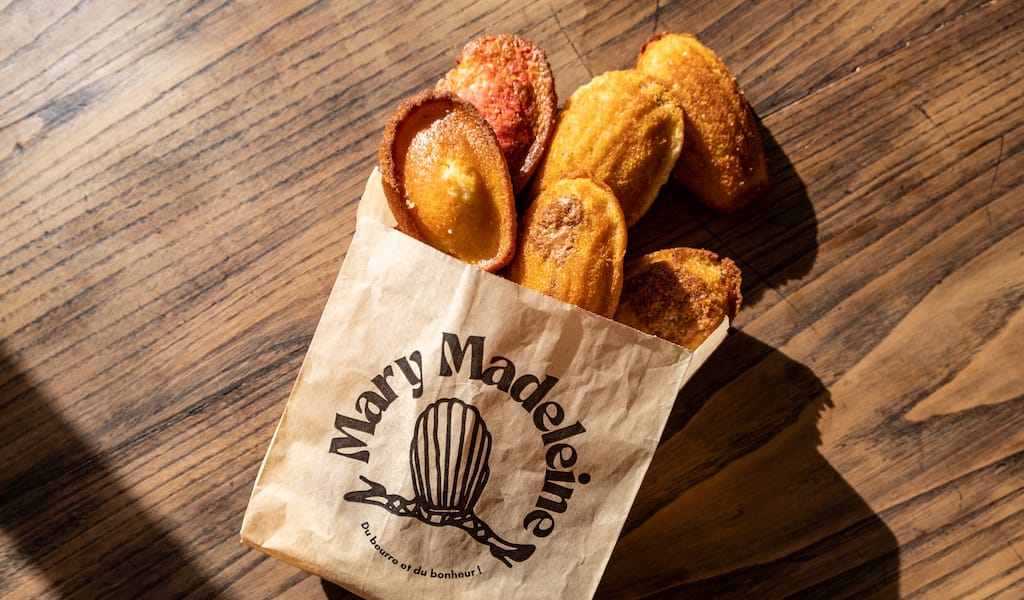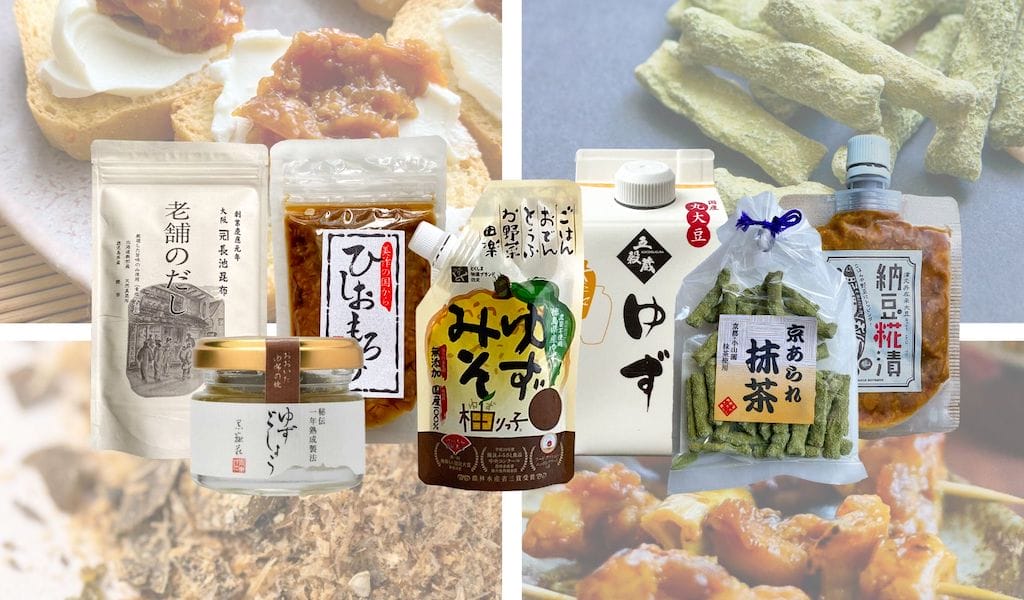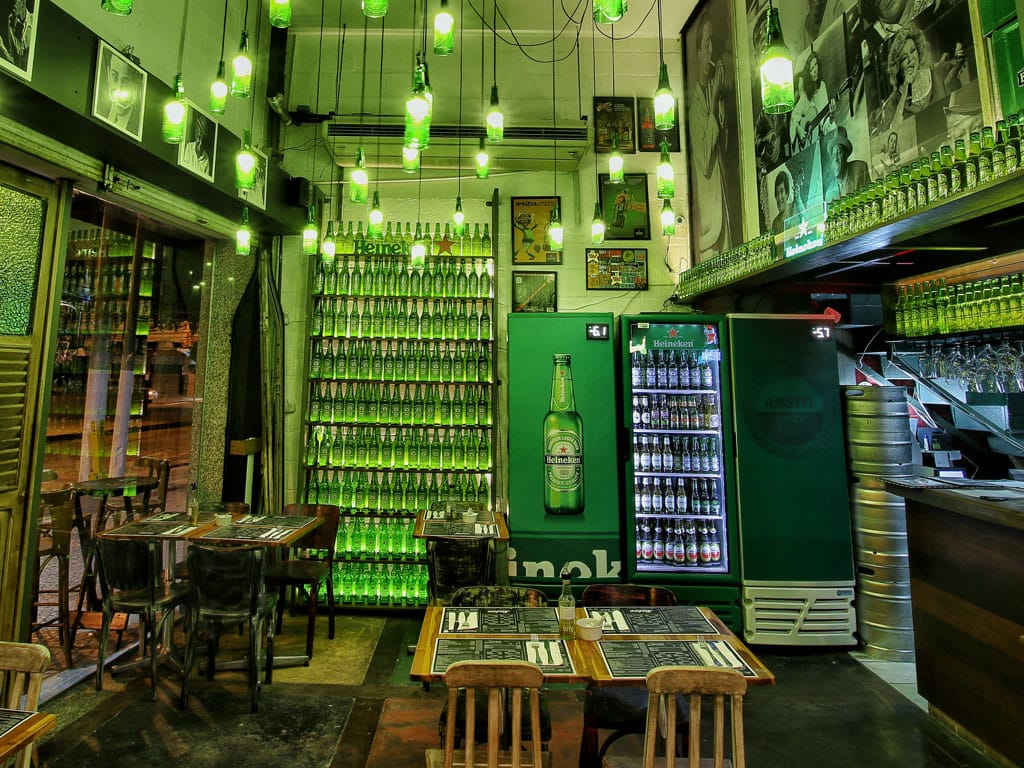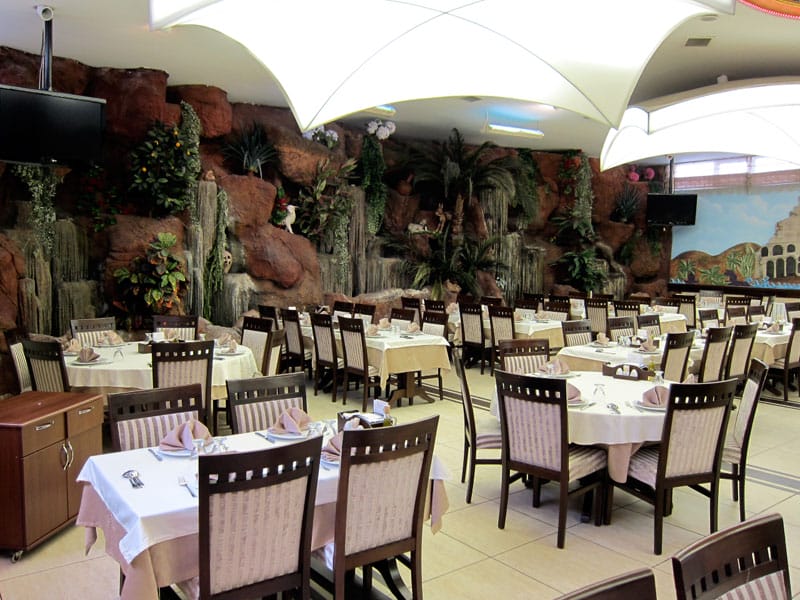Food and memory share an intimate connection that transcends mere sustenance; they weave a tapestry of nostalgia, culture and emotions. There is an inextricable link between food and how we perceive and recall memories, often evoking vivid sensory experiences that transport us through time. Cultural traditions further solidify the bond between food and memory. Sharing a traditional meal becomes a ritual, a way to honor heritage and forge connections with our past. This is especially true in Marseille. The culinary scene surged here in 2023, marked by a new wave of innovative dining experiences.
Renowned for its rich history and diverse population, known as a vibrant melting pot of cultures and flavors, this coastal city has become a playground for chefs and entrepreneurs who are pushing the boundaries of traditional Provençal cuisine. In recent years, a fusion of influences from North Africa, the Mediterranean and beyond has breathed new life into Marseille’s gastronomic landscape. Creative eateries are emerging, blending classic French techniques with exotic spices, fresh seafood and locally sourced produce. From bustling markets to an array of small inventive eateries and late-night bites, Marseille’s culinary renaissance promises a delightful journey for food enthusiasts seeking bold, multicultural flavors in a setting steeped in history and tradition.
Pasta Vesuvio at Otto
The 8ème is the wealthiest arrondissement of Marseille, home to consulates, banks and upscale apartments. Its main thoroughfare, the broad Avenue du Prado, is lined with nondescript restaurants that lack inspiration. Tucked away in a tiny white house behind it, Otto’s decadent pasta dish inspires Marseillais to travel from far and wide.
The Vesuvio is named for Naples’s famous volcano, its creamy, cheesy sauce evoking molten lava and its eponymous spiral-shaped pasta resembling the volcano’s conical shape. Self-taught chef Pierre-Antoine Denis makes this Franco-Italian mac’ n’ cheese by reducing créme fraiche, infusing it with homemade veggie bouillon, mixing in 28-month aged Parmesan, then decadently adding fresh Parm on the pasta for even more oomph. The Italians would scream at the very French cream, yet when every nook & cranny of pasta is blanketed in oozy goodness it’s hard to cry foul. Every table orders the Vesuvio, and every adult becomes a kid again when tucking into its cheesy comfort, ignorant of its carb-loaded calories. Which is why we also order French-toast style panettone and ice cream for dessert without hesitation. – Alexis Steinman
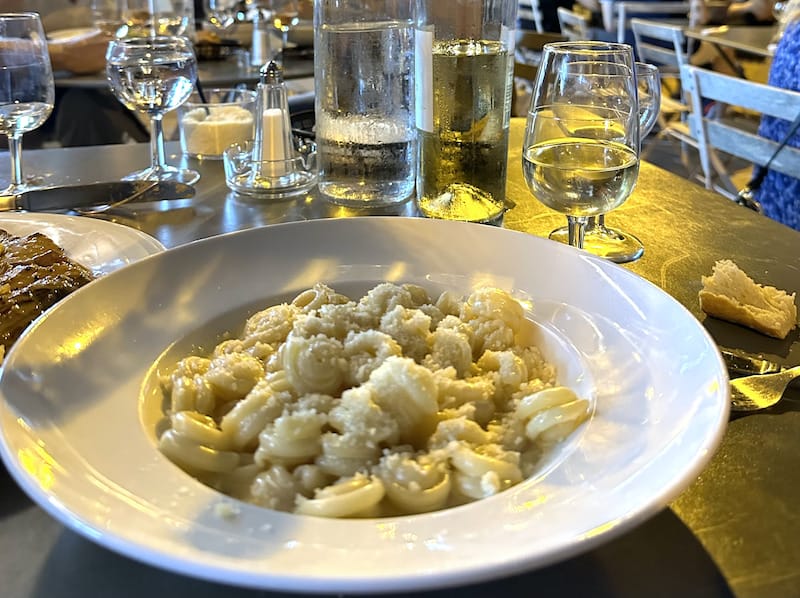
Fatteh at Mouné
I come so often to this Lebanese spot, I’ve become friends with the couple who owns it. Najla Chami’s food is fantastic, and Serje Banna’s warm service has a generous side of wit. Yet, it’s my culinary nerdiness that keeps me coming back for more. Mouné offers a lexicon in Lebanese cooking, so each meal allows me to learn a new dish. Like my new favorite, fatteh.
In Arabic, “fatta” means “to break up in small pieces.” When used in cooking, it often refers to fried leftover pita bread used as a topping. When crumbled on fattoush, a Levantine green salad, the pita adds a nice crouton-like crunch. In fatteh, the fried pita atop garlicky, salted labneh (strained yogurt), and chickpeas becomes even more decadent, like the browned bits of a baked gratin. Though seemingly simple, fatteh’s mix of textures is a flavor bomb, particularly with Najla’s tasty add-ons: buttery pita, creamy labneh, crispy chickpeas, tart pomegranate seeds, toasted pine nuts and bright scallions with a drizzle of luscious olive oil.
I first tasted fatteh at Mouné’s four-year anniversary party, where I shamelessly ate more than my fair share. The next time was during a visit by my brother- and sister-in-law, voracious foodies who were equally smitten. Hopefully it’s on the rotating menu when you go. – Alexis Steinman
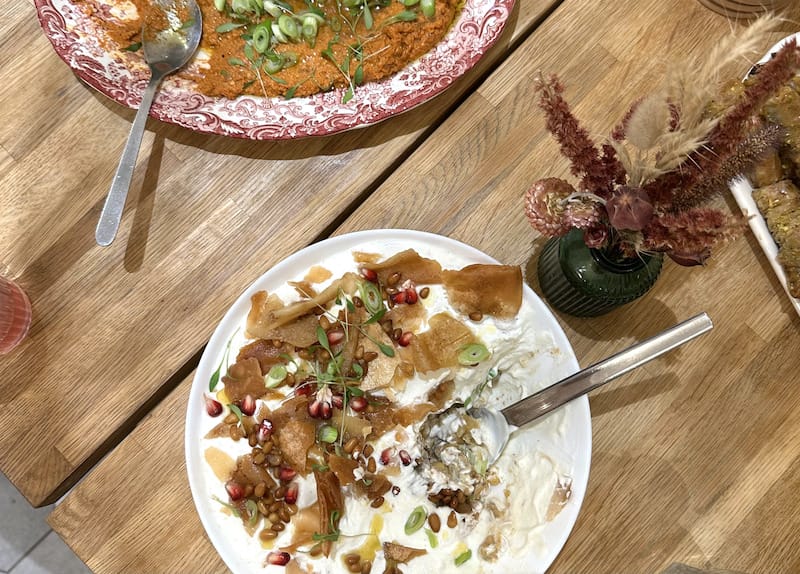
Pork Pistachio Pâté at Carnage
It was the first cold snap in Marseille, a windy November night when the only outside diners are those who choose cigarette proximity over comfort. The time of year when Marseillais swap delicate whites and fish for hearty reds and meat. Just the time to try Carnage. The new carnivorous bar à vin is the little brother to Bouillon, the beloved, meat-centric bistro that is one of our Marseille essentials. This intimate, no-reservation spot serves chef/butcher Auregan Dean’s fantastic charcuterie and Mathieu Zurcher’s choice of natural wines to go or to stay.
We grab a seat inside the stylish vintage-meets-modern space, bathed in a red light that is cozy rather than Amsterdam bawdy. Though the talented Dean has very few misses when it comes to meat, we almost missed a chance to taste the pork and pistachio pâté. Our waitress said it was sold out when we ordered…then she managed to salvage the last one for us. Draped in mustard seeds, the hefty slice decadently marries pork and pistachio fat. So moist it feels naughty, the pâté is tempered with a tannic, peppery Pyrenees red so good we order two bottles – the latter pairs perfectly with the generous cheese plate we can barely finish.
The best part of Carnage? The staff is wonderfully friendly, far from their macabre name (carnage usually refers to “massacre” as well as its lesser known “butchery.”). Fittingly, massacre also means “killing it” in French. Which Carnage is doing in spades. – Alexis Steinman
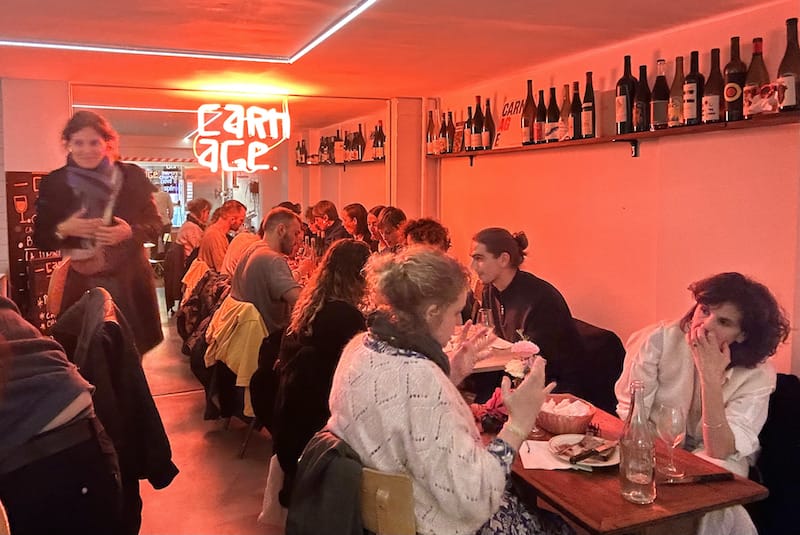
Chevre Miel Pizza at Street Food
We’ve all been there. A night out with friends and on the way home, hunger strikes! In the heart of the Cours Julien neighborhood of Marseille, Street Food is the perfect late-night stop for the favorite late-night bite: pizza, Marseille style. Our hands-down favorite on their menu is the Chèvre Miel. Say what? Goat cheese and honey pizza? Fans of the sweet/savory palette will understand.
This unique pizza variety first emerged as a culinary experiment in the late 20th century, particularly in the Provence region of France. Goat cheese has been a staple in French cuisine for centuries, appreciated for its tangy and creamy profile. Honey, with its natural sweetness, has also been cherished as a versatile ingredient. The marriage of the tangy chèvre with the sweet nuances of honey on a pizza crust became an instant hit and can be found on many pizza menus throughout the south. The toppings often include a generous spread of chèvre, drizzled with honey, and occasionally paired with additional ingredients like walnuts, figs, black olives or arugula.
The lines at Street Food begin when it opens at 6 p.m. and continue until it closes at 12:30 a.m. The concept is simple: no phone, no website, takeout only. They offer a wide variety of classic pizza menu options, but our order is always the same – a single slice of the Chèvre Miel. – Annie Etheridge
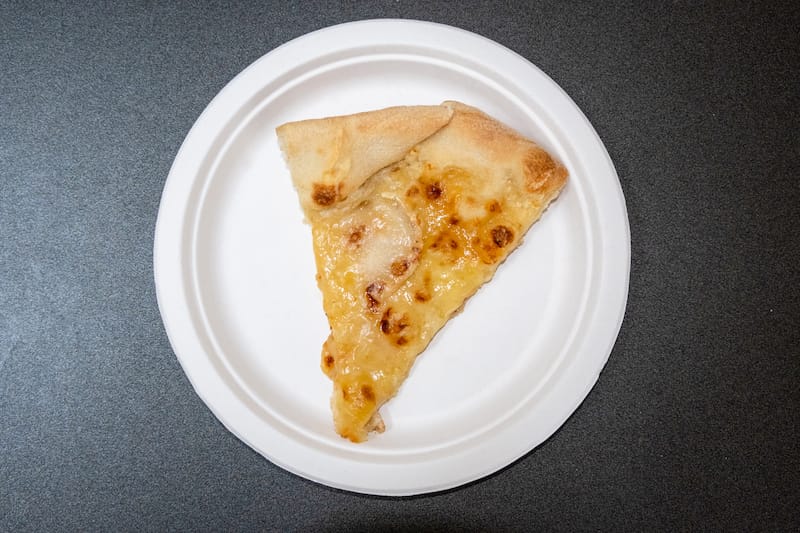
Meatballs at Provisions
Meat and potatoes. A classic and essential meal for many of us during the winter months. For a stick-to-the-ribs leisurely lunch, the meatballs and mashed potatoes from Jill Cousin and Saskia Porretta-Menne at Provisions is a favorite. Since opening their doors in October 2021, the duo has been filling the hearts and stomachs of their loyal customers with a weekly menu that changes and follows the seasons. Prepared by Jill or an invited guest chef, you are sure to enjoy breakfast or a mid-day meal that will blanket the cold.
Jill reminds us that the kitchen is inspired by what is fresh from the markets, so each day can offer different options. Her meatballs with tomato sauce and puréed potatoes is only one of her recipes that recalls a family meal. She adds that throughout the winter months, they will offer menu items such as their delicious homemade sausage with potato purée and a dish of chicken with chanterelle cream and new potatoes. We like to go and be surprised!
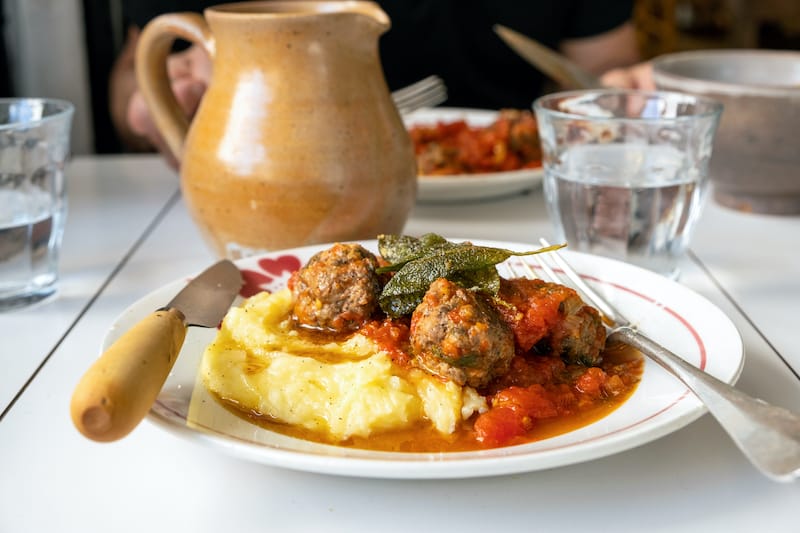
Inside the cozy room, we feel welcome and at home. Cookbooks and children’s books line the wooden shelves that were lovingly preserved from the previously owned family bookstore, the Librairie Internationale Maurel. A curated wine selection with handwritten descriptions is on shelves at the back of the room. Artisanal jams and vinegars peak our curiosity. Sunlight beams through the large windows. In addition to a yummy breakfast or a warm, comforting lunch, Provisions is always a treasure hunt. You never know what treats you may find to take home. On Sundays, breakfast is served all day, and Monday through Wednesday is a short menu of soups, sandwiches, cheese and dessert. – Annie Etheridge
Gratin Dauphinois at Comme à la Maison
It’s a hot debate here in France: cheese or no cheese? The gratin dauphinois, a quintessential French potato dish, boasts a rich history that can be traced back to the 18th century, when it emerged as a simple yet flavorsome peasant dish. Over time, it gained prominence and became a beloved specialty within French cuisine. Its rise in popularity led to its inclusion in cookbooks and the menus of restaurants.
It is precisely the kind of fare we all crave as the temperatures drop. On a recent visit to one of our favorite Marseille traiteurs, Comme à la Maison, we are greeted by father and son, Quentin and Daniel Dessegno. We ask about the proper way to make a Dauphinois and Daniel settles the debate. He explains that a traditional Gratin Dauphinois is made with no cheese, but then adds, “We do add cheese just on the top because it simply tastes better, Gratin Dauphinois the Marseille way!”
Originating from the Dauphiné region in southeastern France, this delectable gratin has evolved over centuries, becoming a celebrated comfort food in French cuisine. The dish’s primary components include thinly sliced potatoes, cream, milk, garlic, nutmeg, and sometimes grated cheese. (Caution! This last ingredient may elicit heated discussion at the dinner table.) The potatoes are delicately layered with the other ingredients and baked.
We stopped by Comme à la Maison precisely for this dish. We love their version of the potatoes and cream delicacy with hints of garlic and nutmeg. On this chilly day, and every day in fact, chef Martine Dessegno bakes it to a golden, cheesy perfection.
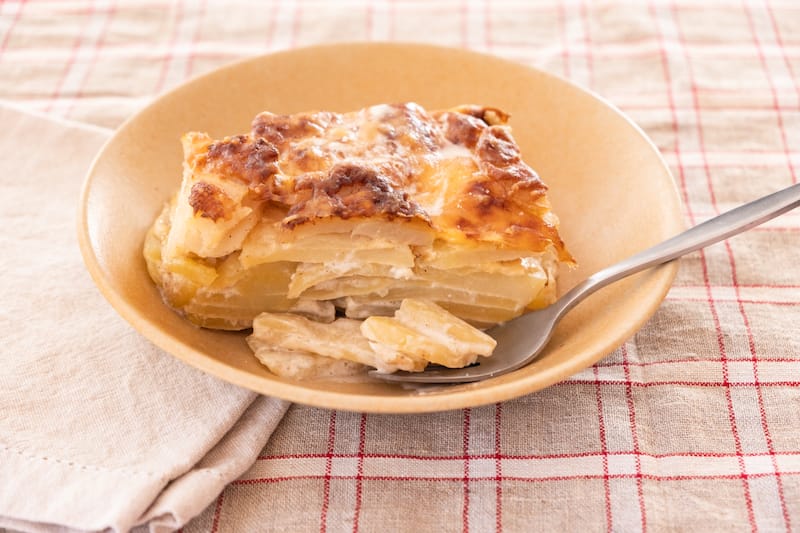
Madeleines at Mary Madeleine
The French madeleine, a small, shell-shaped sponge cake, holds a special place in culinary history and cultural heritage. Its origins trace back to the town of Commercy in northeastern France during the 18th century. Legend weaves the creation of the madeleine with a cook named Madeleine Paulmier, who served in the court of Stanisław Leszczyński, the Duke of Lorraine and the former King of Poland. One story recounts how she crafted these delightful cakes to please the Duke and his guests. Another tale suggests that the recipe was passed down by Madeleine’s grandmother. Regardless of its precise beginning, the madeleine quickly gained popularity.
In the Panier neighborhood of Marseille, Mary Madeleine, a tiny bakery that specializes in the bite-sized treat, has opened its doors. A little over a year ago, Stéphane Mansuy met Marjorie Prévost and Thomas Jaury through friends. After tasting her home-made madeleines and learning about Marjorie’s Burgundian grandmother’s recipe, Stéphane said right then, “There’s something special that other madeleines don’t have – let’s open a shop!”
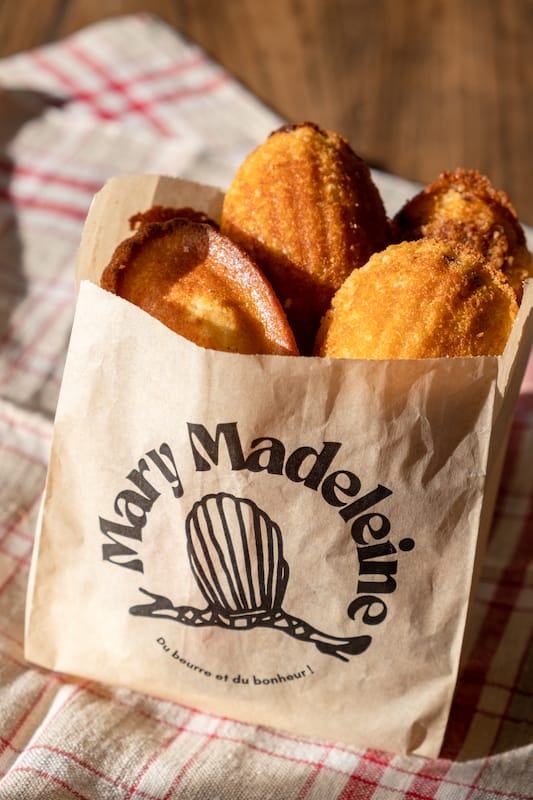
The partners each bring their strengths to the business, which launched in August 2023. Looking to start something new, Stephane recently left his banking career and moved from Luxembourg to Marseille. Marjorie has been in the south for 14 years. She left a retail management position to follow her passion for baking. Thomas manages the company’s social media. Just 5 months after opening the shop, their madeleines have become a favorite among the Marseillais.
Traditional madeleines are made with flour, eggs, sugar, and butter, often flavored with lemon zest, vanilla, or almonds. Baked in shell-shaped molds, they acquire a golden crust with a soft, spongy interior. Mary Madeleine offers the classic recipe, but also specializes in variations, incorporating chocolate, praline, hazelnut, fleur d’oranger, fleur de rose and Speculoos, to name a few, offering a wide array of flavors to suit different preferences. For the holiday season, they are offering a special menu of gingerbread and honey; dark chocolate and candied orange; chestnut cream and slivered almonds, and cinnamon and brown sugar.
It was Marcel Proust, the renowned French writer, who immortalized the madeleine in his literary masterpiece À la Recherche du Temps Perdu (Remembrance of Things Past). Proust vividly describes memories evoked by the taste of a madeleine dipped in tea. His portrayal elevated the madeleine from a mere confection to a symbol of nostalgia and remembrance. After one sweet, buttery bite from Mary Madeleine, we understand that Marjorie’s family recipe is indeed a treat to remember. – Annie Etheridge
 November 16, 2022 The CB 2022 Gift Guide
November 16, 2022 The CB 2022 Gift Guide
Since we’re a company built around the idea that, when traveling, the stomach serves as […] Posted in Elsewhere March 1, 2017 Salve Simpatia
March 1, 2017 Salve Simpatia
Cariocas don’t give much love to Niterói, joking that the only reason to go to this city […] Posted in Rio July 2, 2013 Hatay Has Kral Sofrası
July 2, 2013 Hatay Has Kral Sofrası
In our imaginary primetime lineup, a reality show called “Pimp My Kebab Salon” […] Posted in Istanbul
Published on December 25, 2023
Related stories
November 16, 2022
Elsewhere | By Culinary Backstreets
ElsewhereSince we’re a company built around the idea that, when traveling, the stomach serves as the best compass, it’s no surprise that we believe that culinary experiences are the best kind of gift. And while we would be very happy to see you and your loved ones on one of our culinary walks or trips…
March 1, 2017
RioCariocas don’t give much love to Niterói, joking that the only reason to go to this city across Guanabara Bay is for its spectacular view of Rio de Janeiro. But while less busy and far less popular than Rio, Niterói is full of lovely beaches, great museums, excellent restaurants and hundreds of bars. Among the…
July 2, 2013
IstanbulIn our imaginary primetime lineup, a reality show called “Pimp My Kebab Salon” transforms a drab kebab shop into a grill palace suited to the tastes of the latter-day sultans. Surfaces are suddenly gilded in gold, fountains appear and everything is reupholstered under the watchful eye of the boisterous host with tacky taste. If this…







































